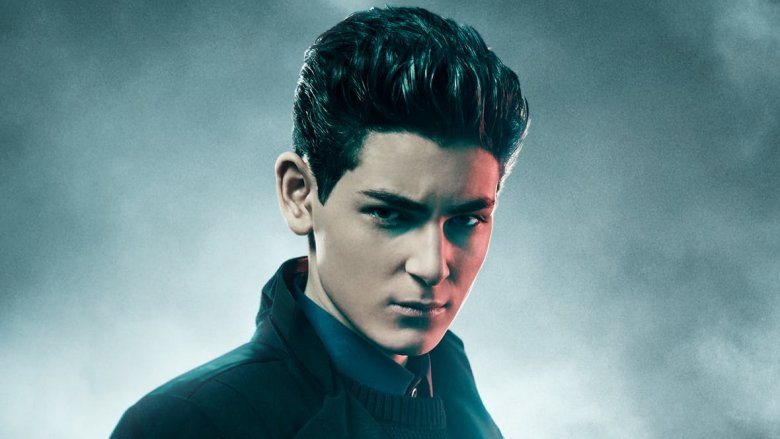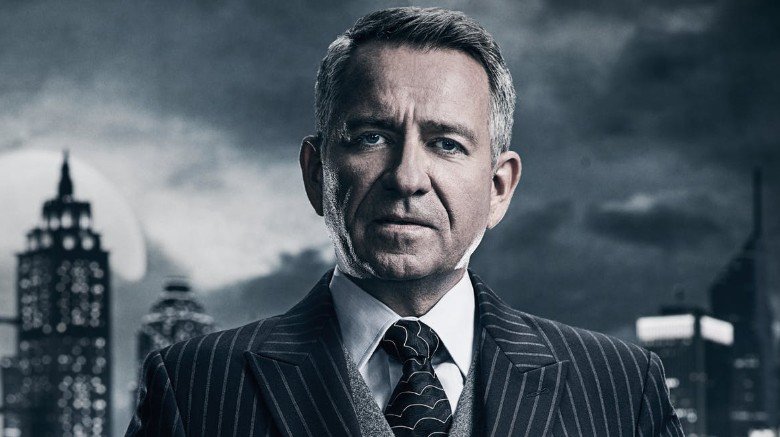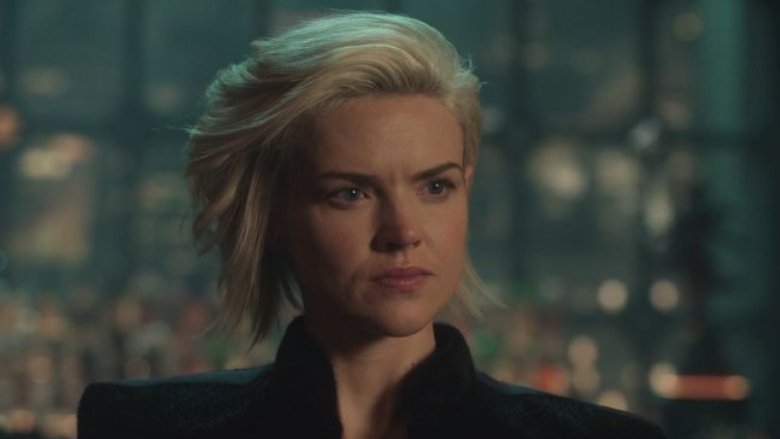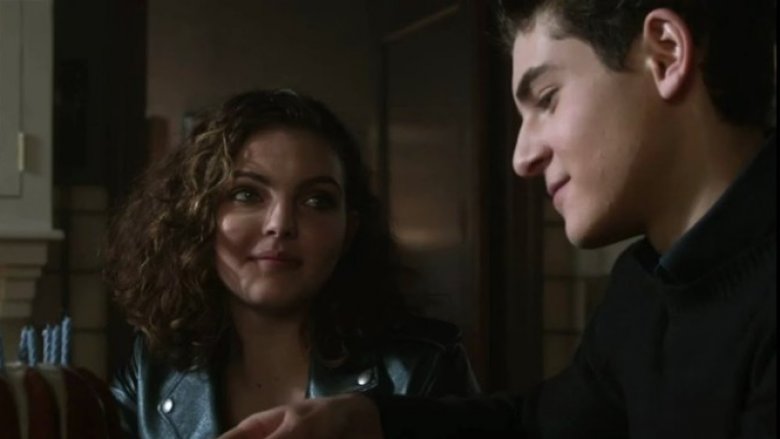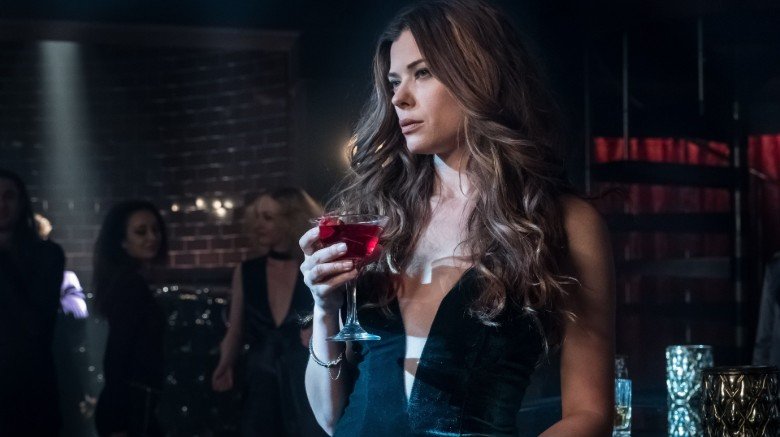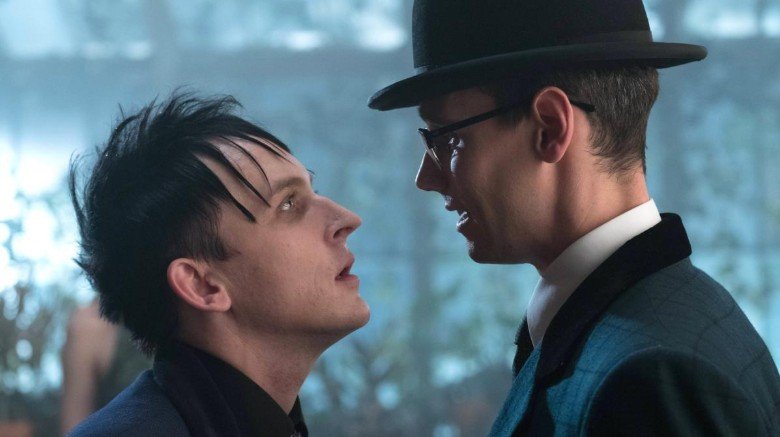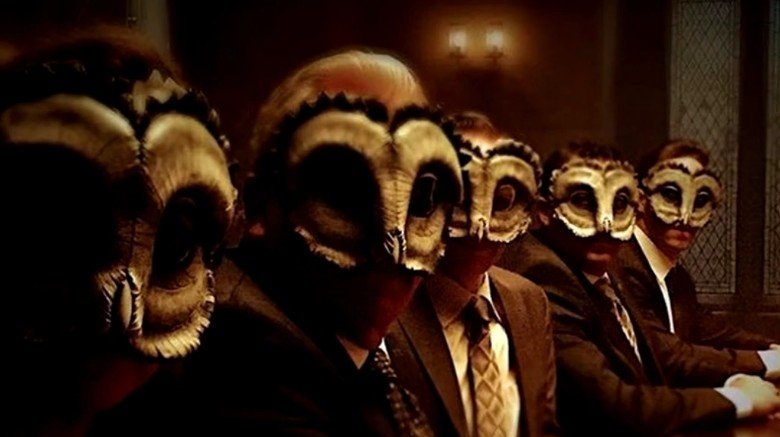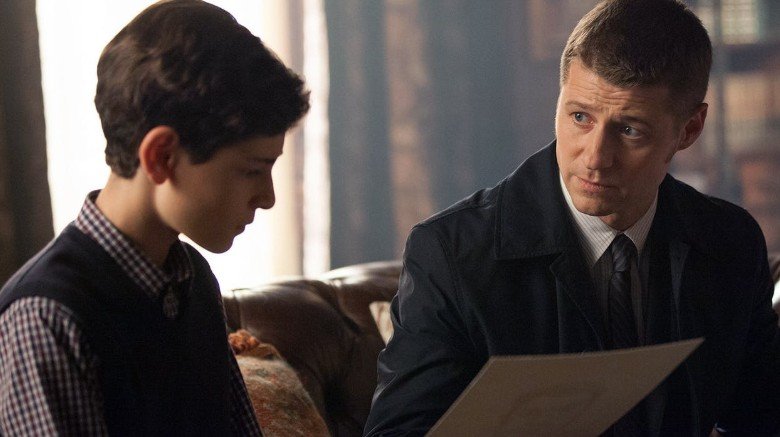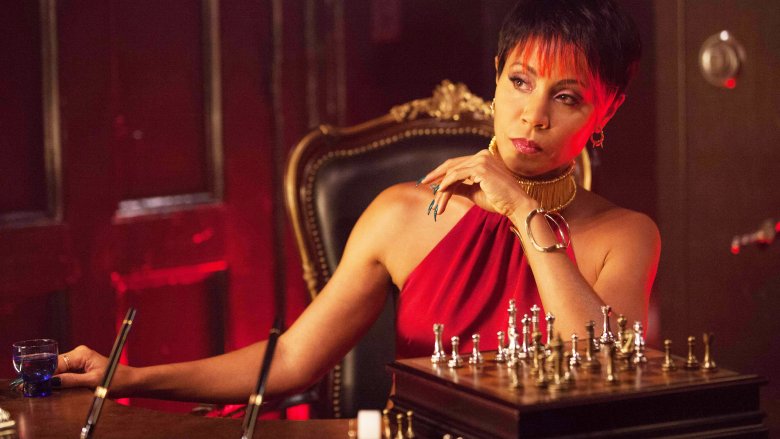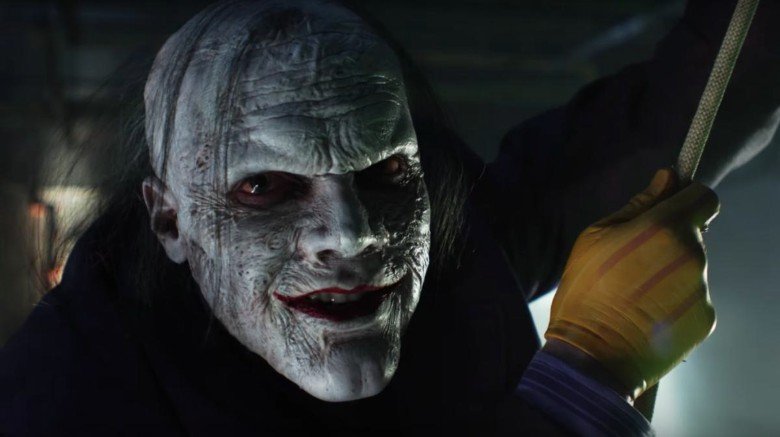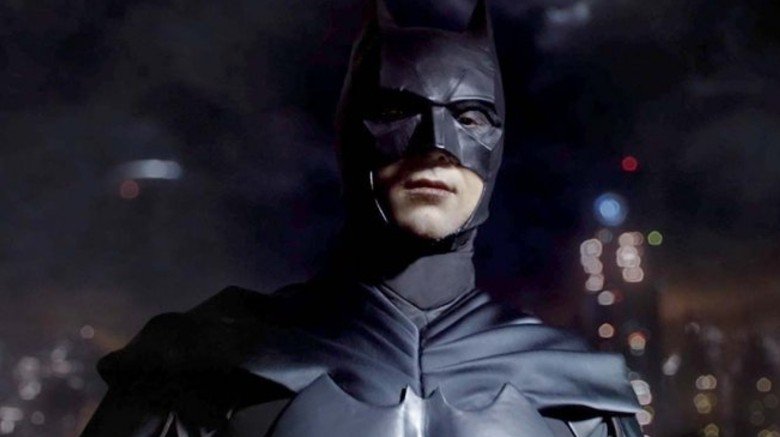How Gotham Completely Changed Batman And No One Noticed
You have to imagine that when Gotham was first pitched, someone understandably said something like, "A Batman show without Batman? How is that going to work?"
Well, apparently it works just fine. At the end of April 2019 Fox aired the Gotham series finale that finally revealed the young Bruce Wayne (David Mazouz) as Batman, costume and all. After five years on the air, Gotham enjoyed a privilege afforded to too few concluding television series — the chance to end on its own terms. Batman rises, James Gordon (Ben McKenzie) becomes Commissioner, and classic Batman bad guys like the Joker (Cameron Monaghan) and the Riddler (Cory Michael Smith) embark on their long, twisted careers.
Batman's comics are adapted so often into television shows, movies, and video games that it's practically impossible to discuss the character without first making sure everyone in the conversation knows exactly which Batman we're talking about. Even if you were to say, for example, you were talking about "the comic book Batman," it would still beg the question of whether you were talking about standard DC Comics continuity, Frank Miller's Dark Knight comics, Terry McGinnis of Batman Beyond who succeeds Bruce Wayne in the role of Batman, etc.
Regardless of how many adaptations and interpretations there are, the more successful ones always leave a mark on the mythology that changes future tellings, and Gotham is no exception. Here's how Gotham changed Batman.
Not just the butler
To DC Comics fans, the notion that Alfred Pennyworth can be as dangerous as he is arrogant is old news, but his covert military background is a new idea to general audiences. While there were brief mentions of the character's military background in Nolan's Dark Knight trilogy, we don't see much of it materialize on-screen.
With Sean Pertwee's take on the character in Gotham, we get a more formidable Alfred Pennyworth. He not only eventually accepts Bruce Wayne's quest for justice, he's the first person to train him. When bullies harass Bruce at school, Alfred teaches him to box. By the end of the series it's commonplace to see Alfred and Bruce fighting bad guys back-to-back.
Once Alfred's old friend and SAS comrade Reggie (David O'Hara) visits Wayne Manor in the first season's "Red Hood," we never see Alfred the same way. How Alfred reacts to Reggie and the darkness we see in him is impossible to unsee once you watch the episode. Afterward you look at Alfred not as a butler, but as someone much more dangerous pretending to butle.
This portrayal has already changed the Batman mythology drastically in that it helped greenlight the new prequel series Pennyworth — starring Jack Bannon as a young Alfred in 1960's London. Seeing Alfred the butler as a hero in his own series wouldn't be feasible without Pertwee's darker, more layered version of the character in Gotham, and you can expect his work to continue to influence future Alfred actors.
Gotham City Sirens
Erin Richards' portrayal of Gotham's Barbara Kean is one of the most blatant ways the series changes Batman's mythology in that it makes the character matter. In the comics, for the most part Barbara exists only as James Gordon's ex-wife. In some versions Barbara dies in a car crash and in some she divorces Gordon, but she is always the woman who used to be with Gordon, and that's it. Her most meaningful appearances are in prequel comics like Batman: Year One.
While the Gordon and Barbara Kean of Gotham are both important to each other, the Kean of Gotham is much more complex than previous incarnations. Kean begins the series as Gordon's fiancee and soon leaves him. Among other things, she unwittingly has an affair with a serial killer and almost becomes his victim. She spends time in the infamous (and largely ineffective) Arkham Asylum and eventually becomes one of the most powerful criminals in Gotham. By the final season, when the city has fallen into chaos and the territory is carved up by warring factions, Kean holds her own piece of the pie with the Sirens Club, which acts as a safe haven for any women in the city. Men aren't allowed in the club, except for a high fee and only for an hour at a time.
Gotham turns a onetime love interest lingering in the background into a complicated character and we're sure to hear echoes of it in other media.
The Bat and the Cat
One of the very first things Gotham changes about Batman's mythology involves Selina Kyle, a.k.a. Catwoman (Camren Bicondova). Fresh from some petty theft, Selina is hiding in the same alley where Thomas and Martha Wayne are tragically murdered. She eventually uses her knowledge of the murder to try to get out of police custody, and her story gets Bruce Wayne's attention. She lives at Wayne Manor for a time and she and Bruce soon become friends. Romance always lingers on the edge of things, just as it has for so long in the comics, eventually leading to their canceled 2018 wedding. Their relationship is always changing in Gotham, often because Bruce grows too close and Selina doesn't like being close with anyone.
Gotham changes the Batman/Catwoman dynamic by establishing a relationship between them earlier than anything we've seen before. It adds weight to their rivalry/romance that has already impacted the comics. Considering Gotham premiered two years before the current Batman comic that saw Bruce and Selina almost get married, and which will soon spawn the mini-series Batman/Catwoman, it seems likely the Bruce/Selina story in Gotham had some influence.
Looking back to Gotham's past
Joker will be released in October 2019 with Joaquin Phoenix starring as the Clown Prince of Crime. What we know about the film doesn't suggest that it's much like Gotham, but regardless there's a good chance it partly owes its existence to the Fox series.
Before Gotham's success, the notion of a Batman TV show or film that wouldn't feature Batman — or any superheroes at all — would seem like a fairly risky venture. Even though Smallville provided a blueprint for Gotham by featuring a young Superman (Tom Welling) acting heroically, that show featured tons of fully-fledged superheroes from the DC Universe. By contrast, Gotham stands out by featuring exactly zero.
But Gotham proves the Batman mythos is popular enough that viewers will show up for a prequel show that doesn't feature Batman himself (until the very end). It's no mistake that Pennyworth's release was announced right after Gotham's penultimate season ended or that Alfred Pennyworth's prequel series premieres the same year Gotham concludes. Likewise, it doesn't seem like coincidence that Joker hits theaters the same year as Gotham's finale. Gotham not only helps make Pennyworth and Joker possible, it leaves a void that needs to be filled.
Gotham provided a new twist on Ivy
Played by three different actresses – Maggie Geha, Clare Foley, and Peyton List — Gotham's Poison Ivy is one of the characters most changed from previous portrayals. In most recent depictions, Poison Ivy's real name is Dr. Pamela Isley. Her plant-manipulation abilities are coupled with an obsession with plants, including believing that humans are less important as what you find in a garden. Gotham's Ivy is less of malevolent Mother Earth and more of a disturbed woman bent on revenge.
She enters Gotham's narrative as Ivy Pepper, daughter to a man wrongly blamed for the murder of Thomas and Martha Wayne. Ivy eventually partners with Selina, gaining her power later in the series after being prematurely aged by Marv (Victor Pagan). While she eventually acts much like her comic book self in terms of threatening Gotham and its citizens with her plants, to Ivy Pepper her plants seem more of a means to an end than the motivation for her villainy.
It's only speculation, but it's possible Gotham's Ivy will soon influence the comic book character. In the comics, Ivy has leaned somewhat toward heroism in recent years and she was one of many heroes killed in DC's 2018-19 mini-series Heroes in Crisis. In Heroes in Crisis #9 we learn that Ivy prepared a plant-clone of herself to be grown in the event of her death. Could this new Ivy prove to be more like Gotham's version?
Gotham's Penguin and Riddler broke new ground
Ever since Gotham's first season, some fans theorized something interesting was going on between Edward Nygma (Cory Michael Smith) and Oswald Cobblepot (Robin Lord Taylor). Calling their pairing "Nygmobblepot", the Internet lit up with Penguin/Riddler romance fan fiction and in Gotham's third season, those fans' wishes were granted — at least partly. The Penguin professes his love for The Riddler.
Unfortunately for Oswald, that love was unrequited. With Nygma's rejection fueling his rage, Cobblepot and Nygma go to war and throughout the series the two continue to have as much hate in their relationship as love.
Speaking to Screener in 2017, Penguin actor Robin Lord Taylor said he doubted his character was capable of actual love. "[Cobblepot] wants true love, but he wants it the way a robot cyborg wants it: Oh, look at that behavior. I want to do that... But without actually knowing what it is, and truly understanding it."
Regardless, for the Penguin to fall in love — or in Cobblepot's twisted version of love — is nothing less than huge. We haven't seen it replicated in the comics yet, but such a change isn't beyond the realm of possibility.
Lights in more of Gotham's corners
By the time Gotham concludes, many of Batman's greatest villains have appeared. There are those you expect, of course: Joker, Riddler, Penguin etc. But Gotham digs deeper into Batman's mythos than you might predict. As a result, any viewer not quite familiar with Batman's rogues' gallery is much more educated about the lesser known dark corners of Gotham, and will remember more villain names beyond the guys from the '60s TV show and the live-action movies.
For all five seasons, Anthony Carrigan appears as Victor Zsasz, a twisted serial killer recognizable to DC comics readers as well as gamer fans of the Arkham series. Right hand man Butch (Drew Powell) eventually transforms into the Frankenstein-esque Solomon Grundy and Mayor Theo Galavan (James Frain) eventually becomes a much different version of Azrael — who in the comics temporarily assumes the mantle of Batman when Bruce Wayne's back is broken by Bane. Mad scientist Hugo Strange (BD Wong) is a recurring character in Gotham and Victor Fries (Nathan Darrow), a.k.a. Mr. Freeze, appears in the fourth season.
Gotham's third season brought one of the Dark Knight's most recently conceived Batman villain groups to the small screen. The powerful secret organization the Court of Owls are villains throughout Season 3 of Gotham. The clandestine group comprised of Gotham's elite wasn't a part of the Batman mythos until they were introduced in the comics in 2011 as part of DC's New 52 reboot.
Gotham re-imagined one of Batman's closest alliances
Bruce Wayne's relationship with Jim Gordon begins much earlier in Gotham than it does in the comics. The closest corollary we see is in Christopher Nolan's Dark Knight trilogy, in which James Gordon (Gary Oldman) briefly meets Bruce Wayne right after his parents are murdered. But even still, there's really nothing else like the bond we see between the two in Gotham.
As early as the first season, James Gordon is a regular visitor at Wayne Manor — usually fielding Bruce's questions or theories about his parents' murders. By Gotham's final season, in spite of Bruce's age, he's one of Gordon's closest allies in the wake of the city becoming a war zone. You get the sense long before Bruce dons the cape and cowl that Gordon has grown to see him as more of a colleague than a child.
In the series finale, it's hinted that Gordon knows Bruce Wayne is Batman, and this actually is similar to the comics. In Frank Miller and David Mazzucchelli's re-working of Batman's origin — collected in the graphic novel Batman: Year One — Gordon sees Bruce Wayne's face after Wayne saves Gordon's infant son. Gordon's glasses fall off earlier and, looking directly in Wayne's face, Gordon says, "You know, I'm practically blind without my glasses." Whether or not he's telling the truth is left purposely ambiguous, but considering he's holding his newborn baby who's only alive because Wayne saved him, it's easy to translate what he says into "I owe you, so I never saw you."
Gotham invented Fish Mooney
For the first three seasons of Gotham, Jada Pinkett Smith played Fish Mooney, one of the series' most intimidating presences. Able to change from seductive to nurturing to terrifyingly fierce in the space between breaths, Fish starts as a club owner aspiring to be the Crime Queen of Gotham. Initially foiled by the equally devious and cowardly Oswald Cobblepot, Mooney refuses to give an inch even when she's kidnapped, brought to an island ruled by the twisted Dr. Dulmacher, a.k.a. the Dollmaker (Colm Feore), and loses an eye in the process.
Though she was one of Gotham's most charismatic villains, Fish Mooney is one of the few major antagonists who has no comic book counterpart. The crime lord was created specifically for Gotham and Jada Pinkett Smith plays her to perfection. We don't know if — like Harley Quinn, who originated in Batman: The Animated Series and later appeared in the comics — Fish Mooney could eventually show up in the pages of Batman or Detective Comics. It would seem almost criminal not to make her a more active part of the mythos eventually. Regardless, in Gotham, she was one of its best villains, if not the best.
Gotham gave the Joker a new identity
For some time, it was a mystery as to who in Gotham would evolve (or devolve, depending on how you look at it) into the infamous Clown Prince of Crime, the Joker. One online theory that made some serious laps across the web in 2014 was that Robin Lord Taylor's Oswald Cobblepot was not the man who would become the Penguin, but instead was secretly the Joker. Online theorists were disappointed when the Joker would prove to be Jeremiah Valeska.
The reveal of Joker's birth name strays from the Batman mythos not because it winds up being Jeremiah rather than his twin brother Jerome, but because the name is revealed at all. Usually, the Joker's name is kept secret — the Joker is the Joker. This is why Christopher Nolan has his Joker (Heath Ledger) tease the audience with multiple stories about his scars. When Alan Moore and Brian Bolland gave fans the 1988 graphic novel Batman: The Killing Joke, they tell a Joker origin story but they never mention his name.
Gotham isn't the first example of Joker being given a name. In 1989's Batman, Jack Nicholson's character is initially named Jack Napier and Sean Murphy uses this name as well for his 2017 mini-series Batman: White Knight. Still, for better or worse, Gotham has done a lot to change the notion that Joker must remain unnamed, and in 2019 we'll see the villain named once more — as Joaquin Phoenix's Arthur Fleck in Joker.
No more Long Halloween
One of the most radical differences between Gotham and the rest of the Batman mythos is something writer Jeph Loeb describes as "the Long Halloween" in his 1997 Batman mini-series of the same name. Something Batman struggles with is that, while he does everything he can to protect Gotham, he winds up being a magnet that attracts insanity to the city. Lunatics like the Joker, Riddler, and Two-Face wouldn't be in Gotham if it weren't for Batman. He's simultaneously the city's savior and the source of its biggest threats.
Gotham turns this idea on its head. Penguin, Riddler, Joker, Zsasz, Solomon Grundy and more all pre-date Bruce Wayne's transformation into Batman by over a decade. The supervillains became the reason Gotham needs Batman rather than Batman's unintended offspring. You could argue the Batman of Gotham's finale is, finally, who Batman was always supposed to be — not the beginning of Gotham's insanity, but its end.
